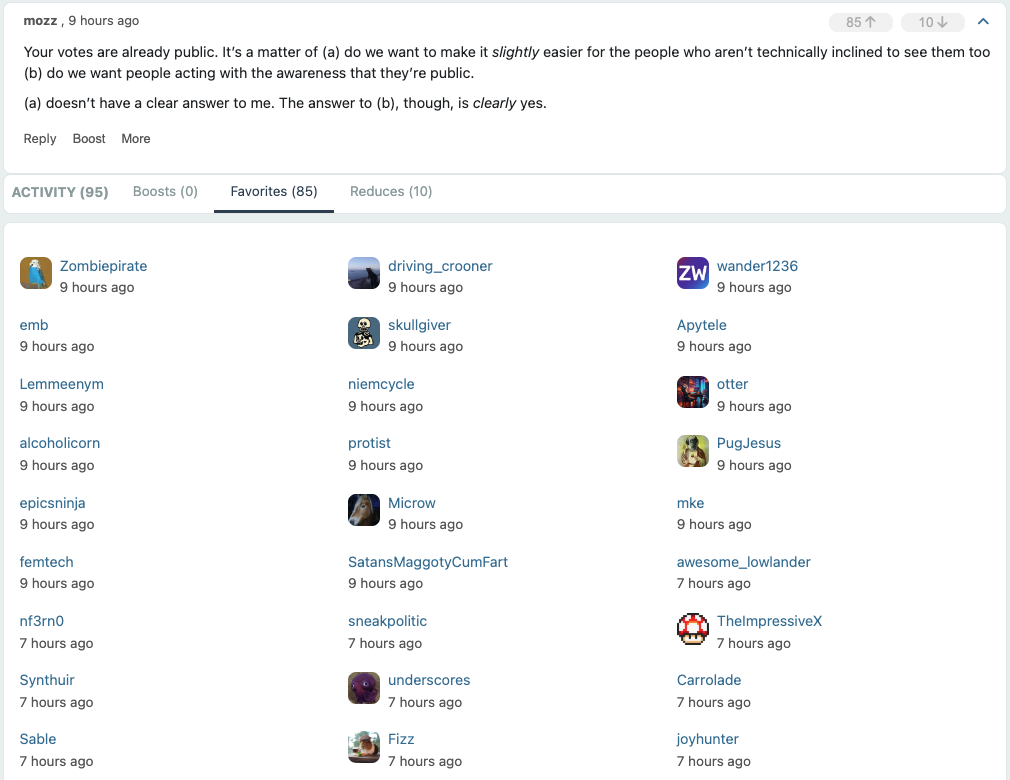


You say that, but you simply have to be using something that isn’t Lemmy and that information is there (doubly so if you’re an admin on any of these systems)



You say that, but you simply have to be using something that isn’t Lemmy and that information is there (doubly so if you’re an admin on any of these systems)


Except, if you’re using anything other than Lemmy at this point that information is already about. The Likes/Dislikes are considered public information by the protocol. Lemmy devs probably just didn’t get around to building out the UI for that before the Reddit APIcolypse.



I’m reading this scratching my head going “If your unit tests need a database they ain’t a unit test”.


All your followers would see it and sometimes you don’t want replies?


I work for the UK government. Everything my organisation does is licensed in either MIT or OGL (https://www.nationalarchives.gov.uk/doc/open-government-licence/version/3/)
Developing code in the open really helps ensure you nail down your secure coding practices.


blocked part of url because I have Kagi rewrite url to redirect to my private Redlib instance
I had no idea this was a thing. Thats going straight on my self-host todo list.


It’s the multiple volumes that are throwing it.
You want to mount the drive at /media/HDD1:/media or something like that and configure Radarr to use /media/movies and /media/downloads as it’s storage locations.
Hardlinks only work on the same volume, which technically they are, but the environment inside the container has no way of knowing that.


Easily doable in docker using the network_mode: "service:VPN_CONTAINER" configuration (assuming your VPN is running as a container)


I’ve not used dockge so it may be great but at least for this case portainer puts all the stack (docker-compose) files on disk. It’s very easy to grab them if the app is unavailable.
I use a single Portainer service to manage 5 servers, 3 local and 2 VPS. I didn’t have to relearn anything beyond my management tool of choice (compose, swarm, k8s etc)


Aside from everyone who’s using flutter?


I’ve not tried it but have been keep tabs.
The two main problems appear to still be ongoing PRs/issues; magazine/community sidebar content doesn’t update and doesn’t federate out at all to lemmy, and moderation actions don’t federate at all (any of the various types) - which is particularly problematic.


If only k/mbin federated better - I’d be all over it :(


You’ve not factored in egress costs. Which on Amazon can add up quite quickly.


There’s a couple of caveats with it, but I think neither are worse than your proposed flow.


Immich does support folders?
https://immich.app/docs/administration/storage-template/
With this you can store your photos in whatever structure you want.


Yes.


Docker will have only exposed container ports if you told it to.
If you used -p 8080:80 (cli) or - 8080:80 (docker-compose) then docker will have dutifully NAT’d those ports through your firewall. You can either not do either of those if it’s a port you don’t want exposed or as @moonpiedumplings@programming.dev says below you can ensure it’s only mapped to localhost (or an otherwise non-public) IP.


Documentation people don’t read
Too bad people don’t read that advice
Sure, I get it, this stuff should be accessible for all. Easy to use with sane defaults and all that. But at the end of the day anyone wanting to using this stuff is exposing potential/actual vulnerabilites to the internet (via the OS, the software stack, the configuration, … ad nauseum), and the management and ultimate responsibility for that falls on their shoulders.
If they’re not doing the absolute minimum of R’ingTFM for something as complex as Docker then what else has been missed?
People expect, that, like most other services, docker binds to ports/addresses behind the firewall
Unless you tell it otherwise that’s exactly what it does. If you don’t bind ports good luck accessing your NAT’d 172.17.0.x:3001 service from the internet. Podman has the exact same functionality.


But… You literally have ports rules in there. Rules that expose ports.
You don’t get to grumble that docker is doing something when you’re telling it to do it
Dockers manipulation of nftables is pretty well defined in their documentation. If you dig deep everything is tagged and natted through to the docker internal networks.
As to the usage of the docker socket that is widely advised against unless you really know what you’re doing.
All votes are public, they’re literally broadcast to the Fediverse writ large. You vote on something on your server, your server then tells the server owning the thing you voted on and that server then tells anyone who is interested (subscribers on other servers). That way everyone knows that this comment was voted on, but that information is indelibly tied to you - an entity on the Fediverse.
Lemmy devs just chose not to a) show that information in a UI (plenty of other software out there does) and b) not inform people that was the case. Which leads to the whole point of the thread, hiding this from users merely gives a false sense of security.